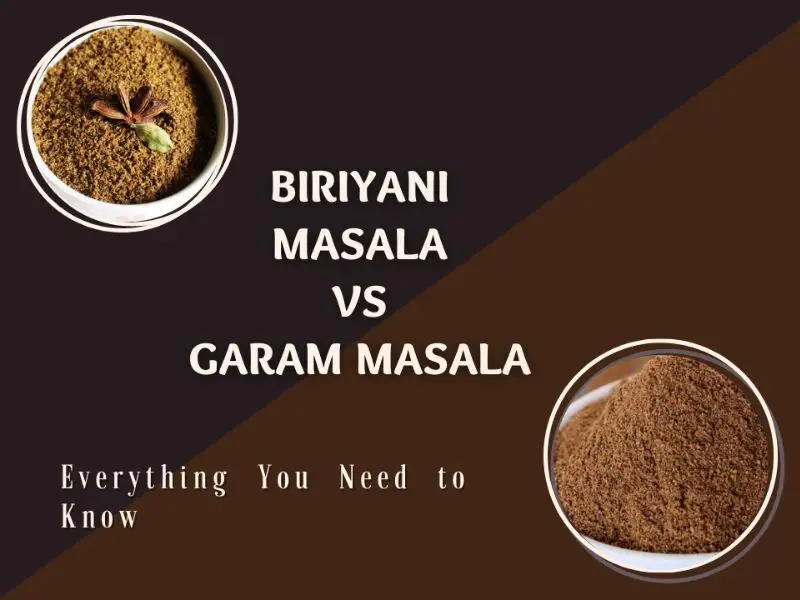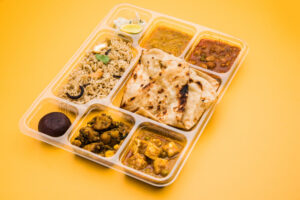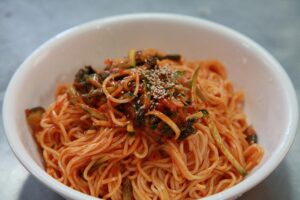Biryani masala and garam masala are a staple in Indian cuisine and can be found in every kitchen. Continue reading to find out the similarities, differences, and everything else about biryani masala vs garam masala. Let’s begin!
Is Biryani Masala And Garam Masala Same?
Biryani masala and garam masala have an almost similar blend of spices. They are just variations of each other. Take a look at the table below for the spices in biryani masala vs garam masala:
| Biryani Masala Spices | Garam Masala Spices |
| Kashmiri red chilies | Mace |
| Bay leaves | Fennel seeds |
| Coriander seeds | Coriander seeds |
| Cumin seeds | Cumin seeds |
| Cinnamon | Cinnamon |
| Green and black cardamom | Green cardamoms |
| Star anise | Star anise |
| Black peppercorns | Black pepper |
| Caraway seeds | Cloves |
Biryani masala and garam masala may have the same composition, but they vary in the proportion of spices used and, therefore, cannot be used interchangeably.
Check out this article on madras curry powder vs garam masala to find out the difference between their spice mixtures.
What Is The Difference Between Garam Masala And Biryani Masala?
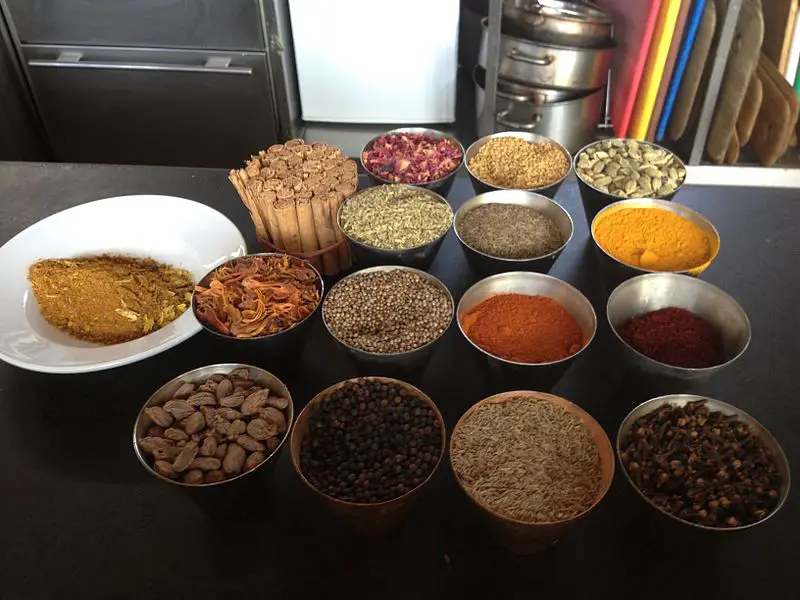
The differentiating factors between biryani masala vs garam masala are:
Smell
Garam masala has an earthy and pungent smell, which will add warmth to your food. In comparison, biryani masala has a pleasant smell that makes your food deliciously aromatic.
Texture
Biryani masala has a slightly coarse texture. Sometimes, whole spices are added to the popular rice dish, biryani, to give it more flavor. However, it can also be made with a fine consistency.
Garam masala is a fine powder that is blended till smooth.
Nutrition
We have listed the estimated calories and other nutritional info about biryani masala vs garam masala in the table below:
| Amount Per Serving | Biryani Masala Powder | Garam Masala Powder |
| Calories | 234 | 65 |
| Fat | 8g | 2g |
| Carbohydrates | 49g | 15g |
| Protein | 8g | 2g |
| Fiber | 29g | 9g |
This is only an estimated account of nutrition in biryani and garam masala. The value may vary according to the number of spices you use.
Flavor
Biryani masala gives any biryani recipe a distinct spicy, aromatic, and exquisite taste.
Garam masala translates to a hot mixture of spices. The word “hot” does not refer to its spiciness. Rather, it signifies the intensity of the flavors. The heat in garam masala comes from black pepper.
How To Make Biryani Garam Masala?
Store-bought garam masala contains preservatives, and you cannot taste the full flavors of the spices. Homemade garam masala will be more flavorful, aromatic, and healthy for you. Here is a video showing how to make garam masala at home.
The following is our version of garam masala, which is plenty flavorful and aromatic. But, before we begin, these are some of the things you should keep in mind:
- Always make sure to buy clean spices to get the most flavors out of them. If the spices have been sitting out in the open for long, then they will have come in contact with dust particles, which will dim their flavor profile. So, it is important to clean the spices beforehand for hygiene purposes.
- Do not blend the spices directly. You always have to roast them on low heat first to accentuate their aroma and to reserve the flavor of the essential oils in them.
- It is important to keep the proportion of spices in check. If you add spice in more quantity than mentioned, then you might experience an irritated bowel, and it will deteriorate your digestion as well.
Ingredients required
- Coriander seeds
- Cinnamon
- Cloves
- Black pepper
- Green cardamom
- Cumin seeds
Optional spices
- Mace
- Nutmeg
- Star anise
- Bay leaf
- Black cardamom
- Fennel seeds
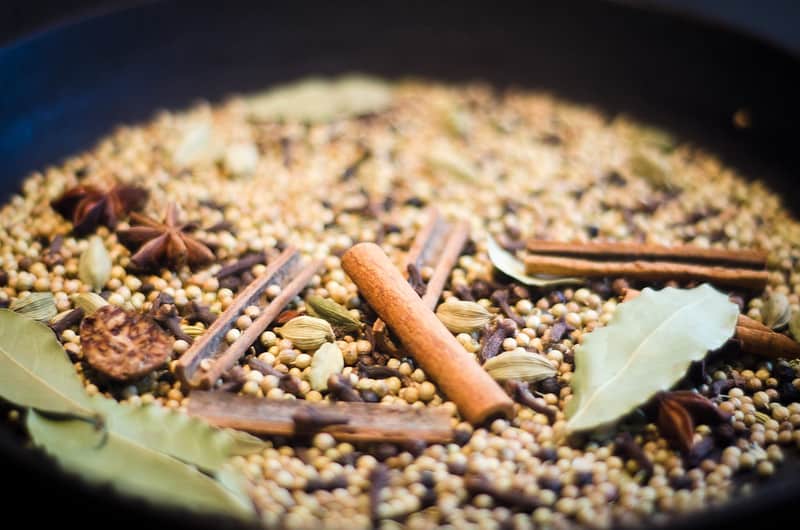
Step-by-step recipe
- Clean the spices thoroughly. Wipe the bay leaves with wet tissue to remove dirt particles from the surface. Pick out any small stones from the dry spices and check them for worms.
- After the spices are clean and safe to use, place them in a pan one by one, and roast on low heat. Let them roast until they are exquisitely aromatic.
- Transfer them to a tray and let them cool completely.
- Once cool, grind them into a fine powder. Sieve the ground spices and, if there are any bigger chunks left, then grind them again.
- And voila! You have your garam masala powder.
Biryani Masala vs Garam Masala: Origin And History
Many variations of the garam masala exist that could be made with as many as 30 ingredients. It is used in many Indian and Pakistani dishes. It is said to have originated in Northern India. It was first used by the Mongolian empire in the 13th century.
There are many theories about the origin of biryani. Some people say that biryani originated from Persia. Another theory suggests that queen Mumtaz Mahal ordered a chef to prepare a balanced and nutritious meal for the under-nourished soldiers, and the dish made was biryani, with a mixture of spices that are called biryani masala.
Biryani Masala vs Garam Masala: Preservation Methods
It is best to store both biryani masala and garam masala in an airtight container to keep the moisture out and retain the aroma. They should be kept in a dry place, away from the sunlight.
Garam masala can be kept at room temperature for about 3-4 months before it goes bad. If the humidity increases, you can refrigerate it for up to 6 months. Or you can store it in the freezer, where it will be good as new for a year.
Biryani masala can be frozen for about a year and stay good. But it will start to lose its aroma after a while, which is why it is recommended to make it in small batches.
How To Make Biryani Masala Powder
Once you make homemade biryani masala powder, you will never go back to store-bought one ever again. Here is a video to help you prepare biryani powder at home.
Biryani Masala – This is how you can make homemade masala powder that can be used to prepare any kind of Biryani. #FoodFood pic.twitter.com/e1DYZY0LWo
— FoodFood (@FoodFood) February 16, 2018
Every person who makes their biryani masala has a unique recipe. Different variations of the biryani masala are used for making different dishes like Hyderabadi biryani, chicken biryani, etc.
The following is your step-by-step guide to making a traditional, aromatic biryani masala powder, which will add many layers of flavor to your food:
Ingredients
- 2 bay leaves
- 3 tsp fennel seeds
- 20 green cardamoms
- 4 black cardamoms
- 2 tsp black pepper
- 4 star anise
- 8 tbsp coriander seeds
- ½ cup cumin seeds
- 1 tsp nutmeg
- 1 tbsp caraway seeds
- 5 Kashmiri red chilies
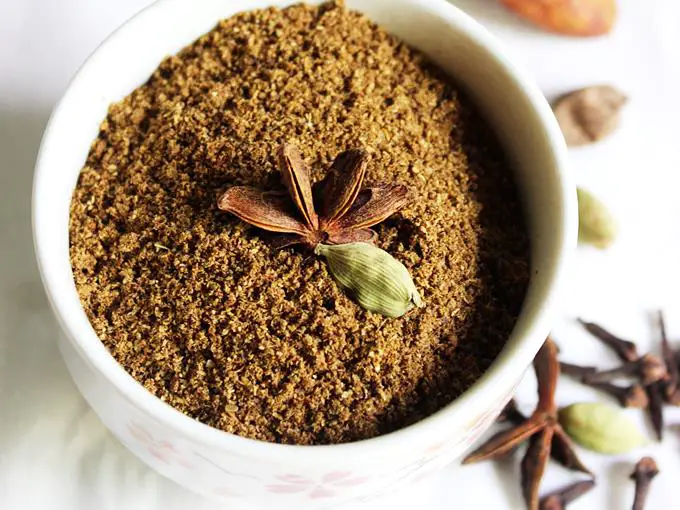
Cooking Instructions
- Make sure that all the spices are clean and that you have picked out all the stones or debris in the ingredients.
- Start dry roasting the spices on low heat, which will extract the full profile of flavors and also prevent burning. You could also sun dry the spices for a day.
- Take the spices off the heat and let them cool in a tray. This step elongates the shelf life of spices.
- Transfer the whole spices to a blender and blend them until smooth.
- Sieve the spices to make sure there are no lumps, and store them in an airtight jar. Now that you can make homemade biryani masala, here is our article on how to cook biryani in the oven, so you can enjoy this flavorful rice delicacy with your whole family!
Health Benefits Of Indian Spices
The ingredients used in making garam masala are especially useful in improving digestion, making it easy for the body to process food.
Take a look at the many health benefits of the spices used in making garam masala and biryani masala:
Kashmiri Red Chilies
Kashmiri red chilies are abundant in antioxidants, vitamin C, and other essential minerals. Its vitamin C content improves the immune system, is good for the skin, and is useful for the body’s health.
Kashmiri chilies are also rich in iron, magnesium, and potassium. Iron is responsible for boosting the number of red blood cells. It is also good for the digestive system.
Coriander Seeds
Coriander seeds are rich in many vital minerals, vitamins, and antioxidants. Its vitamin K content increases bone density and prevents health problems such as osteoporosis.
The antioxidants help reduce the number of free radicals that could potentially cause cancer and heart diseases. Coriander is a medicinal herb that reduces bad cholesterol and blood pressure as well.
Cinnamon
Cinnamon has been used in ayurvedic medicine for many years, and modern science has confirmed its healing properties. Cinnamon will give you an abundant supply of antioxidants.
Cinnamon’s anti-inflammatory properties will give your body the power to fight infections and repair damaged tissues. It also helps people with type 2 diabetes, reduces bad cholesterol, and lowers the risk of heart disease.
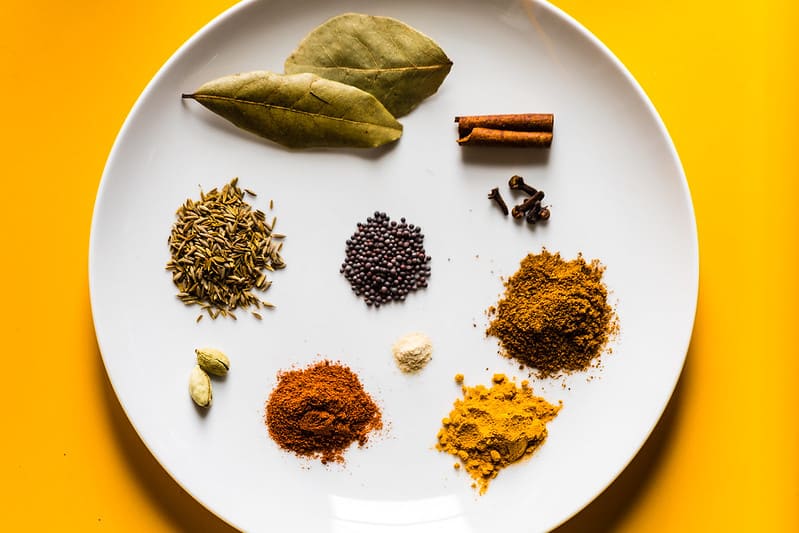
Cumin Seeds
Cumin seeds consist of a compound called flavonoids, which are known for their antioxidant properties. They neutralize free radicals and prevent diseases like cancer and high blood pressure in doing so.
They are perfectly safe to consume in high doses regularly and are free of toxins.
Read this article on garam masala vs ras el hanout and learn more about their spice profile.
If you still have any doubts about garam masala vs biryani masala, here is a dedicated FAQ to help you:
Can I Use Garam Masala For Biryani?
You cannot use whole garam masala for biryani because it is different from biryani masala and cannot be used interchangeably. Using garam masala instead of biryani masala will make a huge difference in the taste of biryani. Though, you can sprinkle it over biryani as a garnish.
Can We Substitute Garam Masala In Vegetable Biryani?
Although you can make vegetable biryani with garam masala, it is not recommended to do so. Instead, you should use biryani masala or chaat masala in the recipe. You can also use a mixture of coriander powder and red chilly powder.
